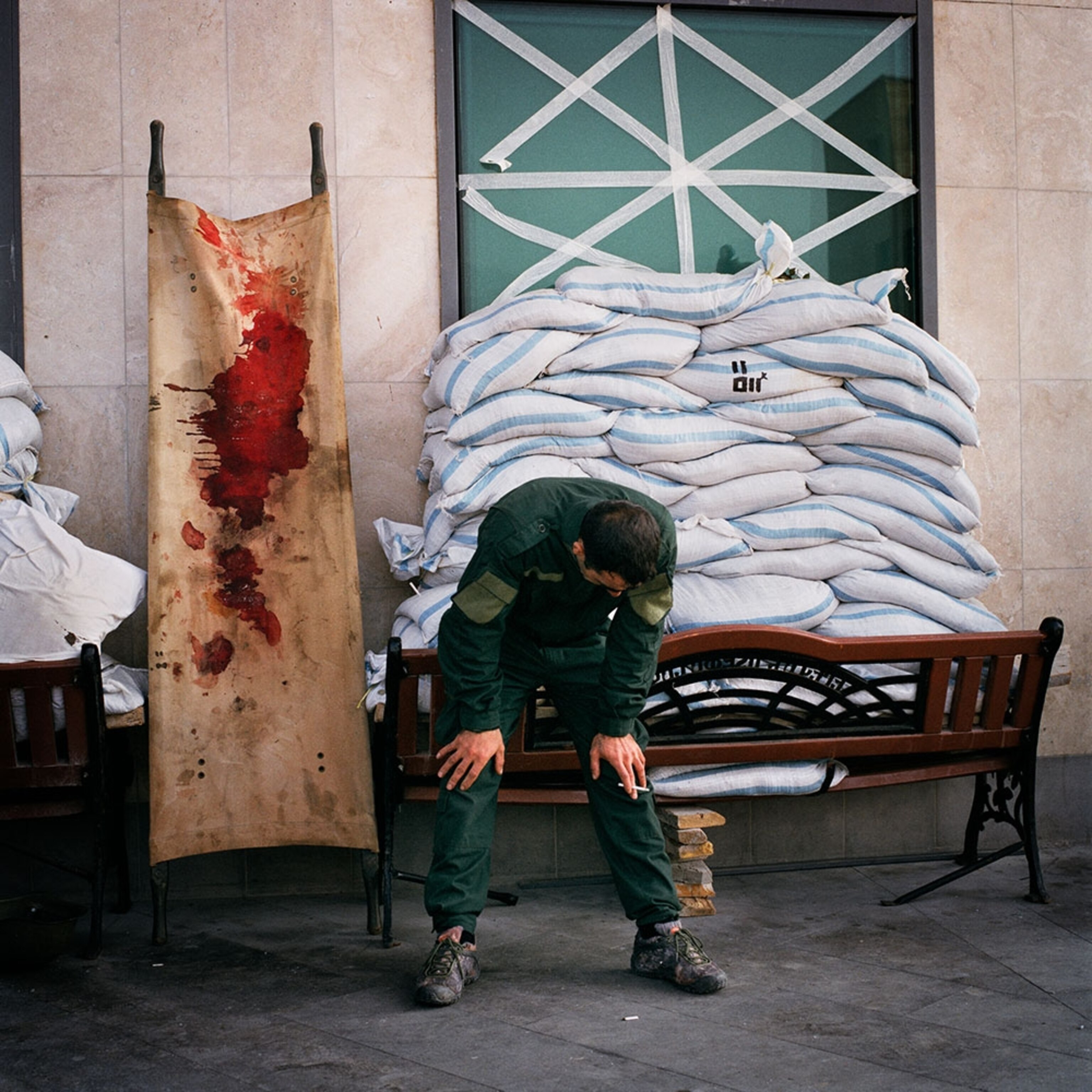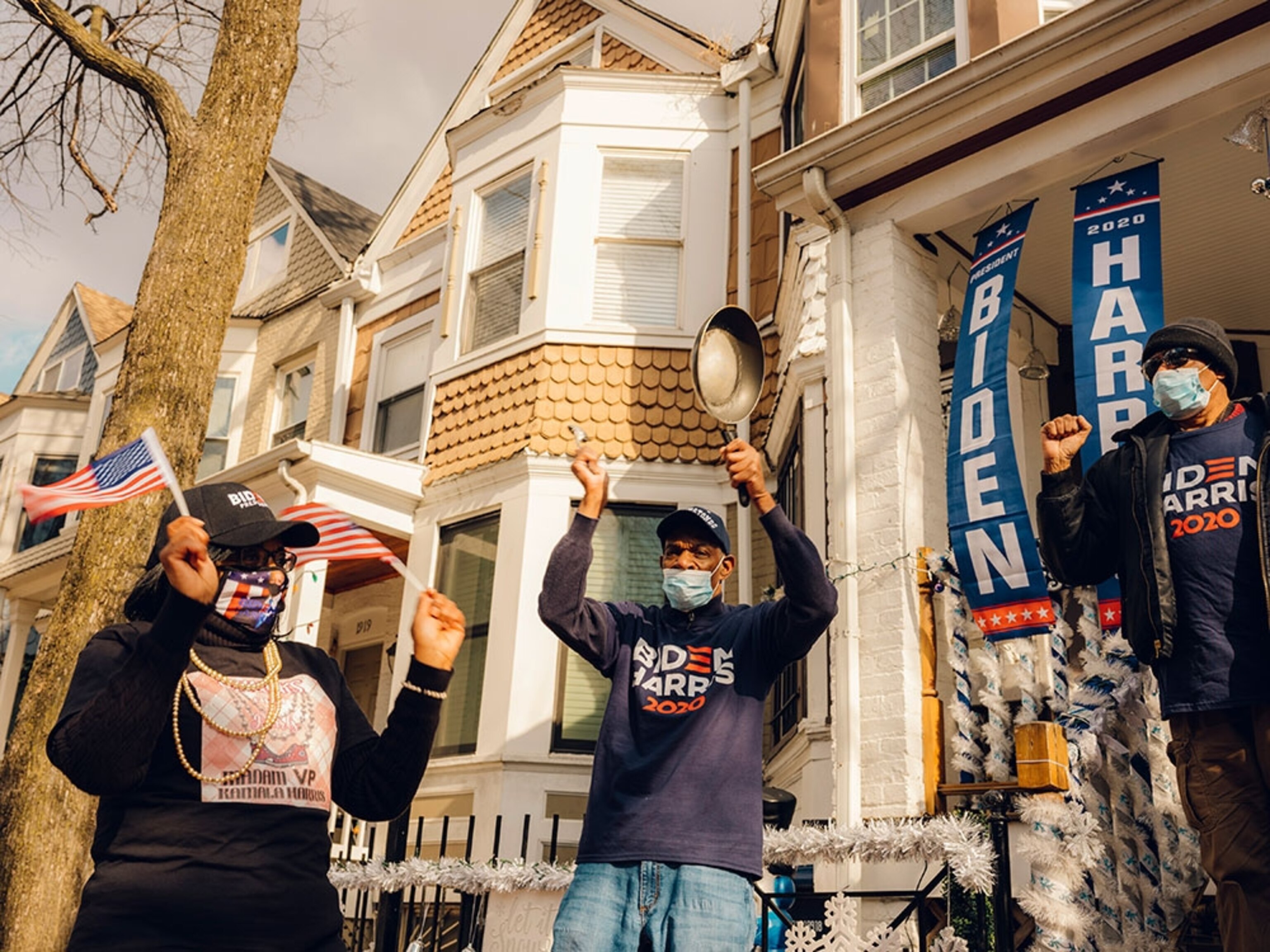
WHERE NO ONE IS UNTOUCHED BY WAR
This article is an adaptation of our weekly Photography newsletter that was originally sent out on January 22, 2021. Want this in your inbox? Subscribe here.
By Whitney Johnson, Director of Visual and Immersive Experiences
I haven’t been able to get this picture out of my head since swiping up to it on Instagram. A man doubled-over, weeping, beside a bloodied stretcher. It’s a single frame that tells an entire story.
This image was made by photographer Anastasia Taylor-Lind, who after working extensively in Nagorno-Karabakh in 2011, returned there late last year to cover the conflict unfolding over the disputed territory. This was the first war to start during the pandemic, and the convergence of the conflict with COVID-19 proved deadly.
Anastasia found a city wholly unrecognizable to the one she photographed in 2011, which, she recalls, was “full of life—families walking the main boulevard, busy shops and restaurants, and that summer, exuberant wedding parties every weekend.” Now, the city was mostly empty except for the hospitals: “The new maternity hospital, damaged by shelling, was inundated with wounded soldiers—and the COVID ward at the Infectious Disease Hospital was full,” she writes.
When I asked her what it was like to visit the places and people who she’d met a decade earlier, she told me: “No one I revisited had managed to remain untouched by the war.”
In 2011, Anastasia photographed then 10-year-old Lilit Gabrielyan at home with her parents. Now Lilit (above) is 19, married, with a 3-month-old son. Her husband, Shura, a soldier, is missing in action.
Father Andreas (above) visits Ghazanchetsots Cathedral in Shushi. Since evacuating as the fighting grew near, Father Andreas returns each day to ring the bell at midday. “With the relentless sound of nearby shelling, he read a quick liturgy in the already bombed church before driving back to the relative safety of Stepanakert,” reports Anastasia. This is a far cry from how she found him before, performing christenings and overseeing weddings in 2011.
Maria Arustamyan (above) was one of the children who Anastasia photographed being baptized by Father Andreas in 2011. Today, Maria has fled to Armenia, along with her mother and four siblings. Her father Grigroy stayed behind to run the emergency department at a hospital in Stepanakert, where Anastasia spent several days photographing seriously wounded combatants. An Armenian fighter (below) was wounded in the battle for a key town the Armenians call Shushi and the Azerbaijanis call Şuşa.
Anastasia’s approach, her slow journalism as I like to think of it, is the only way she knows how to work. In 2015, I visited her in Kyiv, Ukraine, where she was based as she documented the conflict in Donbass, in the east of the country. Six years later, she is still working there, covering the same communities, the same families.
“I ran out of ‘fresh angles’ and ‘news hooks’ years ago,” she writes to me. “What is there to say except the war slowly drags on, affecting every aspect of daily life here.” She continues: “To each of us, our lives, our experiences, our families are our entire universe.” Hear more about Anastasia's approach on our podcast, Overheard.
Note: Anastasia’s photography series was made possible in part by the National Geographic Society’s COVID-19 Emergency Fund for Journalists. If you would like to support storytelling like this, learn more here.
INSTAGRAM OF THE DAY
Wonder: Take a few seconds to appreciate this time-lapse of fireflies dancing under vibrant skies at twilight in Brazil’s Pantanal region. “A bioluminescent 360-degree display danced around me,” says photographer Keith Ladzinski. Fireflies create their bioluminescence through a chemical reaction where oxygen, calcium, adenosine triphosphate, and luciferin are combined. “What this video fails to show is the outrageous abundance of mosquitoes that tormented me while shooting this,” Ladzinski recalled. “I paid a heavy blood tax, but it was worth it.” See the full video with sound on our Instagram page, where it got more than 1.6 million views in the past few weeks.
Blinking in unison: A rare look at synchronous fireflies
TODAY IN A MINUTE
New official White House photographers: Who is capturing the visuals of the White House crew? Adam Schultz will be the chief official White House photographer, after serving as the Biden campaign’s official photographer. Lawrence Jackson, who was the only Black staff photographer during the Obama administration, will be the photographer for Vice President Kamala Harris. “Lawrence has a talent for capturing the big scene, the iconic images that will help explain our times for future generations,” Barack Obama once wrote of him. “But he also has a unique gift for capturing those quieter moments—the margins of a big event, the pauses in a busy day, some stolen time with Michelle and our girls.”
What is the job like? After finishing eight years in the White House with the George W. Bush administration, photographer Eric Draper was tired—and blunt. “This was the hardest job I ever had, and I'd worked eight years at the AP,” Draper told my colleague David Beard. The upside is the stories, such as when Queen Elizabeth II and Prince Philip came to visit. Upstairs one day, in the residence, “Mrs. Bush and the Queen were headed to the other side of the room,” Draper recalled. “I followed them until I realized that Mrs. Bush was taking her to the restroom. And then Philip says, ‘Are you following them to the loo?’ I said, ‘Uh no, I'm not.’” We have more stories in our photo book, The President’s Photographer: Fifty Years Inside the Oval Office, by John Bredar, with an introduction by Reagan and Obama chief photographer Pete Souza.
THE BIG TAKEAWAY
Texting goodbye: Because of the fear of infection, COVID victims often are separated from their families during their final days. Members of six families shared with us their last texts—the manner in which they had to say goodbye—to their loved ones. Wrote Marco Reyes to his father, José. “Old man, I love you so much. I want to walk out of there with you and have a coffee together.” His dad replied: “I love you too. Surely, yes. Take care. Kisses.” The texts and the powerful images by Celeste Sloman moved CNN’s Brianna Keilar to tears on air. (Pictured above, Marco Reyes holding a photo of his dad.)
OVERHEARD AT NAT GEO
Covering a ‘different’ inauguration: From drum circles to leaping dancers to chilled citizens looking at a screen of President Biden speaking, Nat Geo photographers took a unique view at a historically unique once-in-four-year event. See their video. They also helped hosts Peter Gwin and Amy Briggs on “Bicycles, Better Angels, and Biden,” a special episode of our podcast, Overheard. Pictured above, JaNelle Latney (left), David Latney (center), and Stephen Latney celebrate the inauguration from the front of their home in Washington’s LeDroit Park neighborhood of Washington, D.C. The Latney siblings have lived in LeDroit Park since the 1950s.
DID A FRIEND FORWARD THIS TO YOU?
On Mondays, Debra Adams Simmons covers the latest in history. If you’re not a subscriber, sign up here to also get Victoria Jaggard on science, George Stone on travel, and Rachael Bale on animal and wildlife news.
THE LAST GLIMPSE
Swimming in Morocco: A photographer-writer couple, Jean Bowie Thorpe and Franc Shor were struck by this massive oceanside pool, and their image made a 1955 National Geographic story about Morocco, just a year before the French Protectorate in the land was dissolved. Authorities built this municipal pool because the ocean’s undertow was too strong for swimming, says Sara Manco, the senior photo archivist at the National Geographic Society. Of the image, Manco says: “I love the bold colors and the contrast between the drab colored swimming apparatus and the blue ocean and sky.”
This newsletter has been curated and edited by David Beard, and Jen Tse selected the photographs. Kimberly Pecoraro helped produce this, and Amanda Williams-Bryant, Rita Spinks, Alec Egamov, and Jeremy Brandt-Vorel also contributed this week. Have an idea or a link? We’d love to hear from you at david.beard@natgeo.com. Thanks for reading, and have a good weekend!







